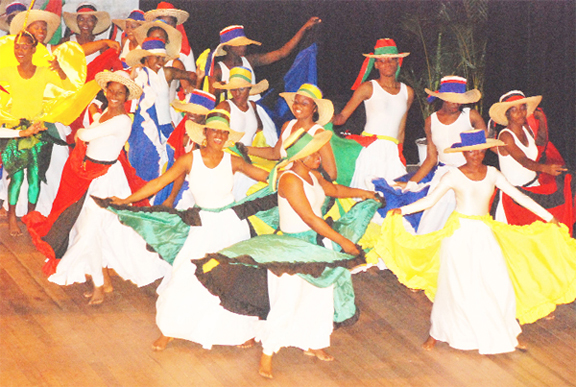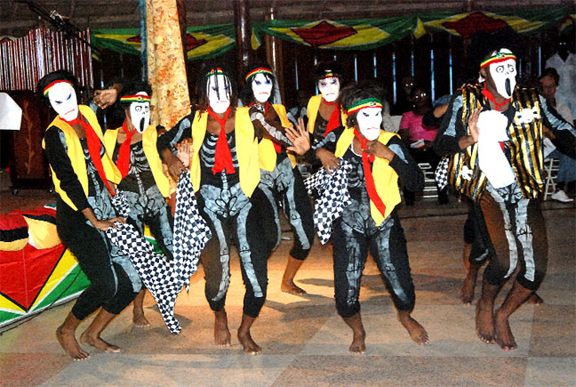Guyana’s National Dance Company presented Suites for its Dance Season 2012 in late November. This was practically a performance of suites of dances taken from different dance forms, themes and explorations, reflecting various shades of the discipline and different studies. In a way the production spoke to the various interests of the company and the kinds of work that it has been doing, providing a pertinent opportunity for reflections on the history of the National Dance Company (NDC); its formation; the role it plays and its relationship with the National School of Dance; the place of the company in dance at a national level; and the present state of the troupe.
Suites was an improvement in the shape of the Dance Season as seen in recent years, although not necessarily in terms of the quality of performance in all respects. Former lead dancer Shevonne Semple appeared in the role of Hostess and has certainly brought stability to the quality of that part of the presentation, having raised the level of narratives and introductions in these programmes. She seems to have settled into this chosen role as well as the role of singer, rather than of dancer. Overall, Suites proved a production of greater weight with emphasis on dance rather than popular appeal, in comparison to other Seasons where they tried to join contemporary trends in modern and popular dance. The emphasis of the NDC in 2012 was on a rewarding international focus.

This suite uses the music Revelations based on ‘Negro spirituals’ – a form that rose out of slavery and the post-emancipation condition. It is Christian gospel music but it is a translation into a conservative Christian consciousness of the experience of the prolonged anguish of a people expressing a vision of heaven carved out of a need for release and healing. It is all reflected in the dance choreographed upon that music by Ailey and reproduced by Vivienne Daniel. Daniel adapted and mounted that work in the Ailey Suite, capturing the atmosphere through her excellent costuming and use of lighting as well as in the quality of the dance. The competence of the dancers in this type of work was in evidence, providing a reminder of their ability to engage with demanding forms of dance.
This ability was further exhibited in the Reggae Suite. This was the reflection of a different reality, but another side of the black experience. The response of the people to this experience, a contemporary post-colonial one, is anything but conservative. Some critics have called it reactionary, but it is explosive and ostentatious, even exhibitionist, and has turned adversity into creativity with the emergence of a culture that has produced forms of dance. This is the urban sub-culture of reggae and dancehall. There have been two approaches to this ‘outrageous’ form on stage: the creation of popular dance, and the study of the setting, the experience and the culture in choreography. The NDC is capable of demonstrating both and has often delved into both. It has tried the popular appeal as well as attempted deeper studies of the setting and culture through imagery, body language and movement related to the musical rhythms.

When contemplating these dances one has to recall the contribution of Rex Nettleford who, through his research and choreographies for the NDTC of Jamaica, gave respectability to folk traditions and the popular culture in mainstream dance theatre. He made serious studies which led the way taken up by others who have strengthened the contributions of the roots forms to contemporary Caribbean dance. Guyana’s NDC performed such serious studies in Suites 2012. In Reflection, Street Lime and The Yard the company went to the context of the dancehall music to create performances that carried on in this tradition. Particularly because of this context, dancehall lends itself to the dramatic, which happens to be a strength of the NDC. Daniel has a very keen sense of theatre which she has passed on to the company, and it was very much in evidence in the highly theatrical presentation that was the Reggae Suite.
This side of dance theatre was followed by an excursion into a very opposite world. In keeping with the range of forms exhibited in the 2012 Season the NDC returned to the foundations of Western dance as practised in the 
One of the other items on show in this programme of varieties was Andante by Daniel to the music of Abba, and performed by the female members of the company. This is one of the better dances in the repertory that the company has performed before, and it did show off the versatility and provide good entertainment. It confirmed their command of different styles as well as the proficiency and consistency of the female dancers. They have always been the stable constant component of the NDC as the strength and presence of their male counterparts have fluctuated and were never nearly as constant as the women. There was a very encouraging upsurge in the very recent years in both the numbers and virtuosity of men in the company. Their performance in the Season of 2012, however showed a drop with only Mario Wilson exuding the command and confidence as an established dancer among the men. He still lends some continuity to male dancing in the company but in this Season they looked a weaker set.
State of the company
And this brings us to some reflection on the state of the National Dance Company. It suffers a continuous turnover of members. The plan seems to have been to maintain a very close relationship with the School of Dance and bring in the advanced students to play supporting roles and select the best of them to join the company as associate members. But while this was a scheme for support and development, it is always called upon to work as a succession plan to replace departing members. Nevertheless this helps to keep the company strong.
The relative places of a national school and a national company, and the relationship between them, however, goes further than that. The company may function as the professional arm of the school in that it provides placement for the best graduates. A fully professional company would pay the dancers so that dancing becomes their career and source of income. As members of the company they build experience, exposure, further knowledge and expertise and are then able to further function as tutors or instructors for the school.
It is also an extension of the school in that it is a theoretical organ. That means members of the company are always engaged in the advancement of dance through research, exposure and the application of what they learn. They operate at a higher level than the school – at the highest national level in the study and exploration of dance and dance forms. They then demonstrate this through their performances. This means the advanced company would showcase forms, explorations and even experimentations of dance in their performances.
The Guyana National Dance Company then, may be expected to research, choreograph and perform dance at the highest level for the entertainment and instruction of the nation. Both the company and the school should provide a career and paid employment for the company’s members as dancers, as well as teachers in the National School of Dance in addition to secondary schools. This, however, might be a fairly ideal state of affairs that may not be operating in Guyana quite so snugly largely because of a lack of resources.
The NDC needs a great deal more material and infrastructural support. A greater allocation of funds would allow it to provide the dancers with an income which would help them to remain in the company.
In Guyana today other private companies can attract them because they can earn from performing. Company members should be made financially secure from their performance as well as teaching in the National School of Dance and in secondary schools where dance programmes may be done. Dance is a part of the CXC Theatre Arts course. A larger input of financing should also cover the other material resources, rehearsal and production costs. In addition, it is very important that the choreographer in particular, and the dancers are able to travel to other countries to participate in tours for exposure to dance and to be refreshed with new creative ideas. These would expand the experience and deepen the work of the NDC.
The government has very recently put out funds to considerably enhance the visual arts through the Guyana Visual Arts Competition and Exhibition, drama through the National Drama Festival and the National School of Drama, and music through the new School of Music and the Song Festival. Similar attention needs now to be turned to dance.




